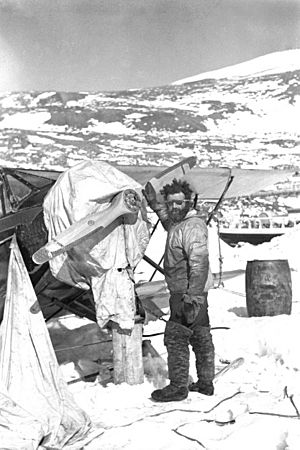Isaac Schlossbach facts for kids
Quick facts for kids
Isaac "Ike" Schlossbach
|
|
|---|---|

Ike Schlossbach warming up the Waco, Spring 1938
|
|
| Born | August 20, 1891 |
| Died | August 1, 1984 (aged 92) |
| Nationality | American |
| Known for | Polar explorer |
Isaac "Ike" Schlossbach (born around August 20, 1891 – died August 1984) was an amazing American adventurer. He was a brave polar explorer, a skilled submarine pilot, and a pioneer in aviation.
Ike was born in Bradley Beach, New Jersey. He grew up in Neptune Township, New Jersey, where he went to Neptune High School.
Contents
Ike's Military Adventures
In 1911, Ike Schlossbach made history. He became the first Jewish midshipman at the United States Naval Academy in Annapolis, Maryland. While there, he was a star athlete, playing football and wrestling.
After graduating in 1915, Ike chose to join the very first submarine school. During World War I, he commanded submarines in the Mediterranean Sea. Imagine being in charge of a submarine under the sea during a war!
In 1921, after the war ended, Ike joined the Navy's aviation team. He was one of the first to train with "lighter-than-air" flying machines, like dirigibles. By 1922, he also learned to fly regular airplanes.
By 1925, Ike, now a Lieutenant Commander, was leading an air squadron. His squadron flew a record-setting flight over South America. Later, he led the first squadron to serve on the Navy's first aircraft carrier, the USS Langley.
Ike had a problem with his left eye. Because of this, the Navy assigned him to teach engineering and aviation at the Naval Academy. He even coached the football team! In 1930, at age 38, Ike had to retire from the Navy because he lost his eye.
Just before the U.S. entered World War II, Ike led a small team. They set up an airport at Fort Chimo in Labrador in 1941. Even though he was retired, he helped out again during World War II. He served bravely when assigned to Guadalcanal.
Exploring the Arctic and Antarctic
Ike Schlossbach loved exploring the coldest parts of the world. He went on twelve polar trips. Three of these were to the Arctic (the North Pole region) and nine were to the Antarctic (the South Pole region).
In 1931, he joined the Wilkins Trans-Arctic Expedition. He was the navigator on the USS Nautilus. This was the first time anyone tried to take a submarine under the icepack to the North Pole.
Ike also commanded Admiral Richard Byrd's ship, the Bear of Oakland. He was a pilot on Byrd's Second Antarctic Expedition (1933–35). He was also second-in-command on the MacGregor Arctic Expedition (1937–38). During this trip, he achieved many "firsts" in polar aviation. In 1939, he went with Byrd to the Antarctic again on the United States Antarctic Service Expedition.
After World War II, Ike was second-in-command on the last private Antarctic expedition. This was the 1946–1948 Ronne Antarctic Research Expedition. He commanded a large wooden tugboat called Port of Beaumont. This ship got stuck in the ice in Back Bay all winter. Ike also went with Finn Ronne to a cape in the Weddell Sea, which was named after Ike! A mountain was also named after him.
In 1955, Ike joined an Australian research trip to Ellsworth Station in Antarctica. The Australian government even sent him a special letter to thank him.
In 1956, Admiral Byrd chose Ike to be his personal helper for Operation Deep Freeze. Ike went with Byrd on other trips too. His last journey to the Antarctic was in 1961 when he was 70 years old. He went as a consultant for the United States Navy.
Ike was given three special Congressional medals. These awards recognized his important work in exploring Antarctica.
Other Cool Accomplishments
Before World War II, Ike Schlossbach started an airport. It was in Asbury Park and was first called Schlossbach Field. It was also known as Gibson Air Academy.
His amazing adventures took him all over the world! He traveled to the South Pacific, New Zealand, Australia, the Philippines, and South America. Of course, he also explored the Arctic and Antarctica. Ike never married. He passed away in 1984 at the age of 93.
Timeline of Ike's Life
| Years | Age | What Ike Did – Where |
|---|---|---|
| 1891–1911 | 0–19 | Growing up – Neptune City |
| 1911–1915 | 20–24 | Naval Academy Student – United States Naval Academy, Annapolis |
| 1915–1921 | 23–29 | US Navy Submarine Service – World War I – Mediterranean Sea |
| 1921-192x | 30-x | Naval Aviator – Aircraft carrier USS Langley |
| 192x-1930 | x-38 | Teacher and Coach – United States Naval Academy |
| 1930–1931 | 39–40 | Wilkins Trans-Arctic Expedition – Nautilus – Arctic |
| 1933–1935 | 41–44 | Byrd's Second Antarctic Expedition – Antarctica |
| 1936 | 45 | Founded Schlossbach Field (Airport) |
| 1936–1938 | 46–47 | MacGregor Arctic Expedition – Etah, Greenland |
| 1939–1940 | 48–50 | United States Antarctic Service Expedition (Byrd's Third Trip) – Antarctica |
| 1941 | Ungava Bay Expedition – Canada | |
| 1942-194x | 51-x | United States Navy – World War II – Guadalcanal |
| 1946–1948 | 55–57 | Ronne Antarctic Research Expedition – Antarctica |
| 1949–1954 | 58–63 | Managed Asbury Park Air Terminal |
| 1955 | 64 | Australian National Research Expedition – Antarctica |
| 1956–1957 | 65–66 | Operation Deep Freeze I – Antarctica |
| 1957–1958 | 66–67 | International Geophysical Year (Operation Deep Freeze II) – Antarctica |
| 1958–1959 | 68–69 | Operation Deep Freeze – Antarctica |
| 1960–1961 | 70 | Consultant to US Navy in Antarctica (Operation Deep Freeze V) – Antarctica |
| 1962–1984 | 71–93 | Retirement |
See also
 In Spanish: Isaac Schlossbach para niños
In Spanish: Isaac Schlossbach para niños

